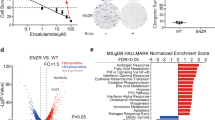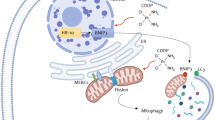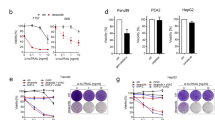Abstract
In this study, we asked whether overexpression of caspase-3, a central downstream executioner of apoptotic pathways, might sensitize breast cancer cells with acquired drug resistance (MT1/ADR) to drug-induced apoptosis. As control, we employed caspase-3 negative and caspase-3-transfected MCF-7 cells. Whereas mock-transfected MCF-7 cells were resistent to epirubicin, etoposide and paclitaxel (taxol), the same drugs led to breakdown of nuclear DNA in caspase-3-transfected MCF-7 cells. MT1/ADR cells express low levels of wild type caspase-3 but show defective caspase activation and apoptosis upon drug exposure. These cells also display a less efficient activation of the mitochondrial permeability transition. Caspase-3-transfected MT1/ADR clones showed a 2.8-fold increase in the protein level and a 3.7-fold higher specific enzyme activity. Procaspase-3 overexpression was not toxic and did not affect background apoptosis. Interestingly, procaspase-3-transfected MT1/ADR cells were more sensitive to cytotoxic drugs as compared with vector-transfected controls and DNA fragmentation nearly reached the levels of the original drug sensitive MT1 cells. Thus, overexpression of caspase-3 enhances chemosensitivity especially in situations where activation of the mitochondrial apoptosome is disturbed.
This is a preview of subscription content, access via your institution
Access options
Subscribe to this journal
Receive 50 print issues and online access
$259.00 per year
only $5.18 per issue
Buy this article
- Purchase on Springer Link
- Instant access to full article PDF
Prices may be subject to local taxes which are calculated during checkout









Similar content being viewed by others
References
Bargou RC, Daniel PT, Mapara MY, Bommert K, Wagener C, Kallinich B, Royer HD, Dörken, B . 1995 Int. J. Cancer 60: 854–859
Bargou RC, Wagener C, Bommert K, Mapara MY, Daniel PT, Arnold W, Dietel M, Guski H, Feller A, Royer HD, Dörken B . 1996 J. Clin. Invest. 97: 2651–2659
Cohen GM . 1997 Biochem. J. 326: 1–16
Cohen JJ, Duke RC, Fadok VA, Sellins KS . 1992 Annu. Rev. Immunol. 10: 267–293
Cosset FL, Takeuchi Y, Battini JL, Weiss RA, Collins MK . 1995 J. Virol. 69: 7430–7436
Daniel PT, Pun KT, Ritschel S, Sturm I, Holler J, Dörken B, Brown R . 1999 Blood 94: 1100–1107
Ellis RE, Yuan JY, Horvitz HR . 1991 Annu. Rev. Cell Biol. 7: 663–698
Essmann F, Wieder T, Otto A, Müller EC, Dörken B, Daniel PT . 2000 Biochem. J. 346: 777–783
Fisher DE . 1994 Cell 78: 539–542
Hannun YA . 1997 Blood 89: 1845–1853
Hiwasa T, Tokita H, Sakiyama S, Nakagaware A . 1998 Anticancer Drugs 9: 82–87
Ibrado AM, Huang Y, Fang G, Bhalla K . 1996a Cell. Growth. Differ. 7: 1087–1094
Ibrado AM, Huang Y, Fang G, Liu L, Bhalla K . 1996b Cancer Res. 56: 4743–4748
Jänicke RU, Sprengart ML, Wati MR, Porter AG . 1998a J. Biol. Chem. 273: 9357–9360
Jänicke RU, Ng P, Sprengart ML, Porter AG . 1998b J. Biol. Chem. 273: 15540–15545
Kerr J, Wyllie A, Currie A . 1972 Br. J. Cancer 26: 239–257
Krajewski S, Blomqvist C, Franssila K, Krajewska M, Wasenius VM, Niskanen E, Nordling S, Reed JC . 1995 Cancer Res. 55: 4471–4478
Krammer PH, Behrmann I, Daniel P, Dhein J, Debatin KM . 1994 Curr. Opin. Immunol. 6: 279–289
Kroemer G, Reed JC . 2000 Nat. Med. 6: 513–519
Kuida K, Zheng TS, Na S, Kuan C, Yang D, Karasuyama H, Rakic P, Flavell RA . 1996 Nature 384: 368–372
Laemmli UK . 1970 Nature 227: 680–685
Liu X, Kim CN, Yang J, Jemmerson R, Wang X . 1996 Cell 86: 147–157
Lotem J, Sachs L . 1993 Cell Growth Differ. 4: 41–47
Miller AD, Rosman GJ . 1989 Biotechniques 7: 980–982, 984–986, 989–990
Miyashita T, Reed JC . 1993 Blood 81: 151–157
Naundorf H, Rewasowa EC, Fichtner I, Buttner B, Becker M, Gorlich M . 1992 Breast Cancer Res. Treat. 23: 87–95
Nicoletti I, Migliorati G, Pagliacci MC, Grignani F, Riccardi C . 1991 J. Immunol. Methods 139: 271–279
Perkins C, Kim CN, Fang G, Bhalla KN . 1998 Cancer Res. 58: 4561–4566
Prokop A, Wieder T, Sturm I, Eßmann F, Seeger K, Wuchter C, Ludwig W-D, Henze G, Dörken B, Daniel PT . 2000 Leukemia 14: 1606–1613
Slee EA, Harte MT, Kluck RM, Wolf BB, Casiano CA, Newmeyer DD, Wang HG, Reed JC, Nicholson DW, Alnemri ES, Green DR, Martin SJ . 1999 J. Cell Biol. 144: 281–292
Slee EA, Keogh SA, Martin SJ . 2000 Cell Death Differ. 7: 556–565
Smith PK, Krohn RI, Hermanson GT, Mallia AK, Gartner FH, Provenzano MD, Fujimoto EK, Goeke NM, Olson BJ, Klenk DC . 1985 Anal. Biochem. 150: 76–85
Stein U, Walther W, Lemm M, Naundorf H, Fichtner I . 1997 Int. J. Cancer 72: 885–891
Sturm I, Köhne C-H, Wolff G, Petrowsky H, Hillebrand T, Hauptmann S, Lorenz M, Dörken B, Daniel PT . 1999 J. Clin. Oncol. 17: 1364–1374
Sturm I, Papadopoulos S, Hillebrand T, Benter T, Lück H-J, Wolff G, Dörken B, Daniel PT . 2000 Int. J. Cancer 87: 517–521
Suzuki A, Kawabata T, Kato M . 1998 Eur. J. Pharmacol. 343: 87–92
Thornberry NA, Lazebnik Y . 1998 Science 281: 1312–1316
Uckert W, Willimsky G, Pedersen FS, Blankenstein T, Pedersen L . 1998 Hum. Gene Ther. 9: 2619–2627
Wagener C, Bargou RC, Daniel PT, Bommert K, Mapara MY, Royer HD, Dörken B . 1996 Int. J. Cancer 67: 138–141
Wesselborg S, Engels IH, Rossmann E, Los M, Schulze-Osthoff K . 1999 Blood 93: 3053–3063
Wieder T, Geilen CC, Wieprecht M, Becker A, Orfanos CE . 1994 FEBS Lett. 345: 207–210
Wieder T, Orfanos CE, Geilen CC . 1998 J. Biol. Chem. 273: 11025–11031
Wieder T, Eßmann F, Prokop A, Schmelz K, Schulze-Osthoff K, Beyaert R, Dörken B, Daniel PT . 2001 Blood 97: 1378–1387
Wyllie AH . 1980 Nature 284: 555–556
Xiang J, Chao DT, Korsmeyer SJ . 1996 Proc. Natl. Acad. Sci. USA 93: 14559–14563
Zhou Q, Snipas S, Orth K, Muzio M, Dixit VM, Salvesen GS . 1997 J. Biol. Chem. 272: 7797–7800
Acknowledgements
This work was supported by research grants from the Deutsche Forschungsgemeinschaft (SFB 273 and SFB 506), the European Community TMR Program, the University Medical Center Charité and the Berliner Krebsgesellschaft.
Author information
Authors and Affiliations
Rights and permissions
About this article
Cite this article
Friedrich, K., Wieder, T., Von Haefen, C. et al. Overexpression of caspase-3 restores sensitivity for drug-induced apoptosis in breast cancer cell lines with acquired drug resistance. Oncogene 20, 2749–2760 (2001). https://doi.org/10.1038/sj.onc.1204342
Received:
Revised:
Accepted:
Issue Date:
DOI: https://doi.org/10.1038/sj.onc.1204342
Keywords
This article is cited by
-
Acquisition of paclitaxel resistance modulates the biological traits of gastric cancer AGS cells and facilitates epithelial to mesenchymal transition and angiogenesis
Naunyn-Schmiedeberg's Archives of Pharmacology (2022)
-
The role of individual caspases in cell death induction by taxanes in breast cancer cells
Cancer Cell International (2015)
-
Effect of Smac on TRAIL-induced apoptosis of prostate cancer cell line PC-3 and the molecular mechanism
Journal of Huazhong University of Science and Technology [Medical Sciences] (2012)
-
The non-steroidal anti-inflammatory drugs Sulindac sulfide and Diclofenac induce apoptosis and differentiation in human acute myeloid leukemia cells through an AP-1 dependent pathway
Apoptosis (2011)
-
Differential chemosensitization of P-glycoprotein overexpressing K562/Adr cells by withaferin A and Siamois polyphenols
Molecular Cancer (2010)



